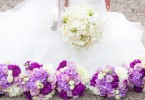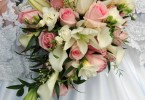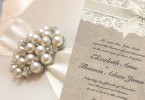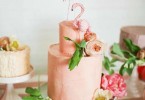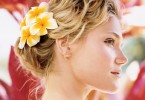Flowers form an integral part of any wedding. They are present at both ceremony and the reception, but were you aware of the hidden meaning of many different types of flower? When it comes to picking your wedding flowers you might want to read on to make sure you the blooms you pick are sending out the right message!
Choosing your flowers for your wedding can be a tricky task, a lot will depend on your wedding colors, your budget, and the style of your wedding. But flowers are steeped in symbolism and their meanings date from the Victorian era when the Victorians went made for all things romantic!
Your groom should wear a buttonhole with flowers that match those in your bouquet. This tradition comes from medieval times when a knight would wear the colors of the lady that he loved as a declaration of his affection for her.
In ancient times, the Greeks, Persians, Indians and Chinese all gave symbolic meanings to flowers. Lady Mary Wortley Montague, the wife of a British Ambassador to the Turkish Sultan is accredited with bringing the language of flowers back to England in 1716. However, it was not until the Victorian era that this language became a science and every flower, leaf and blade of grass were codified along with all their colors, various combinations, and orientations.
Just to confuse things further the meaning of flowers changed depending on where they were worn. Even the type of ribbon they were attached to could add extra significance, turning a marriage proposal into a refusal or vice versa. The strategic placement of a nosegay could express sentiment and emotion as effectively as a handwritten note, however only those that knew the code could decipher its meaning.
If a young lady was to receive a bouquet of jonquils and snowdrops then she knew her potential suitor shared an affection and had hopes of continued friendship. However a bouquet of orange roses, meaning passion, returned to the sender with the blooms facing downwards then this was a clear sign to tell him to clear off!
The language of flowers is as interesting as it is complex but choosing your wedding flowers according to their meaning can have extra special significance. An orange blossom, for instance, means chastity, purity and loveliness, whilst red chrysanthemums say ‘I love you’.
Use the following list of popular flowers and their meanings to create your bouquet and other wedding flower arrangements. You could also use their colors for your reception decorations to add energy and the atmosphere to your wedding room.
Acacia -Friendship
Azalea -Temperance
Bluebell -Constancy
Buttercup -Youthfulness
Camellia, red -Excellence
Chrysanthemum, white -Optimism
Cowslip -Pensiveness
Daffodil -Regard
Heliotrope -Devotion
Jasmine -Cheerfulness
Lilac -Innocence
Lotus -Eloquence
Oleander -Caution
Pansy -Thoughtfulness
Peony -Bashfulness
Thistle -Austerity
Violet, blue -Modesty

